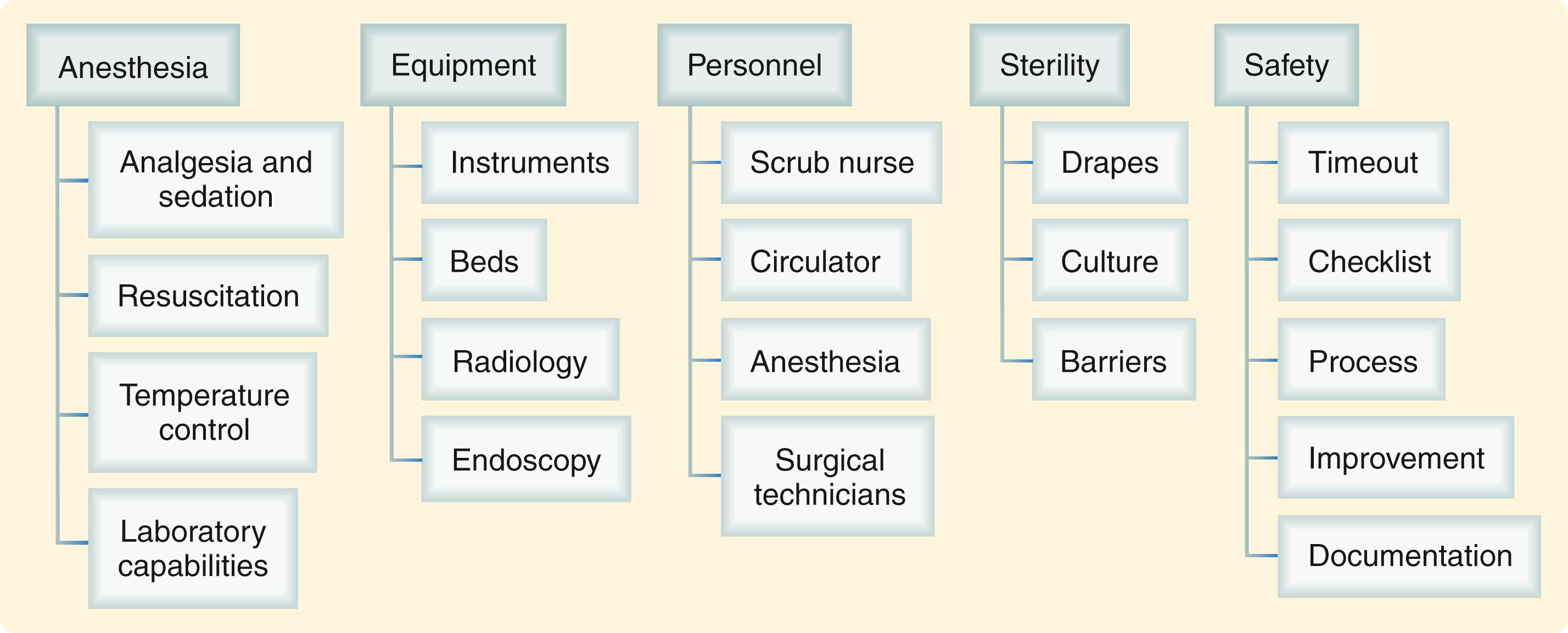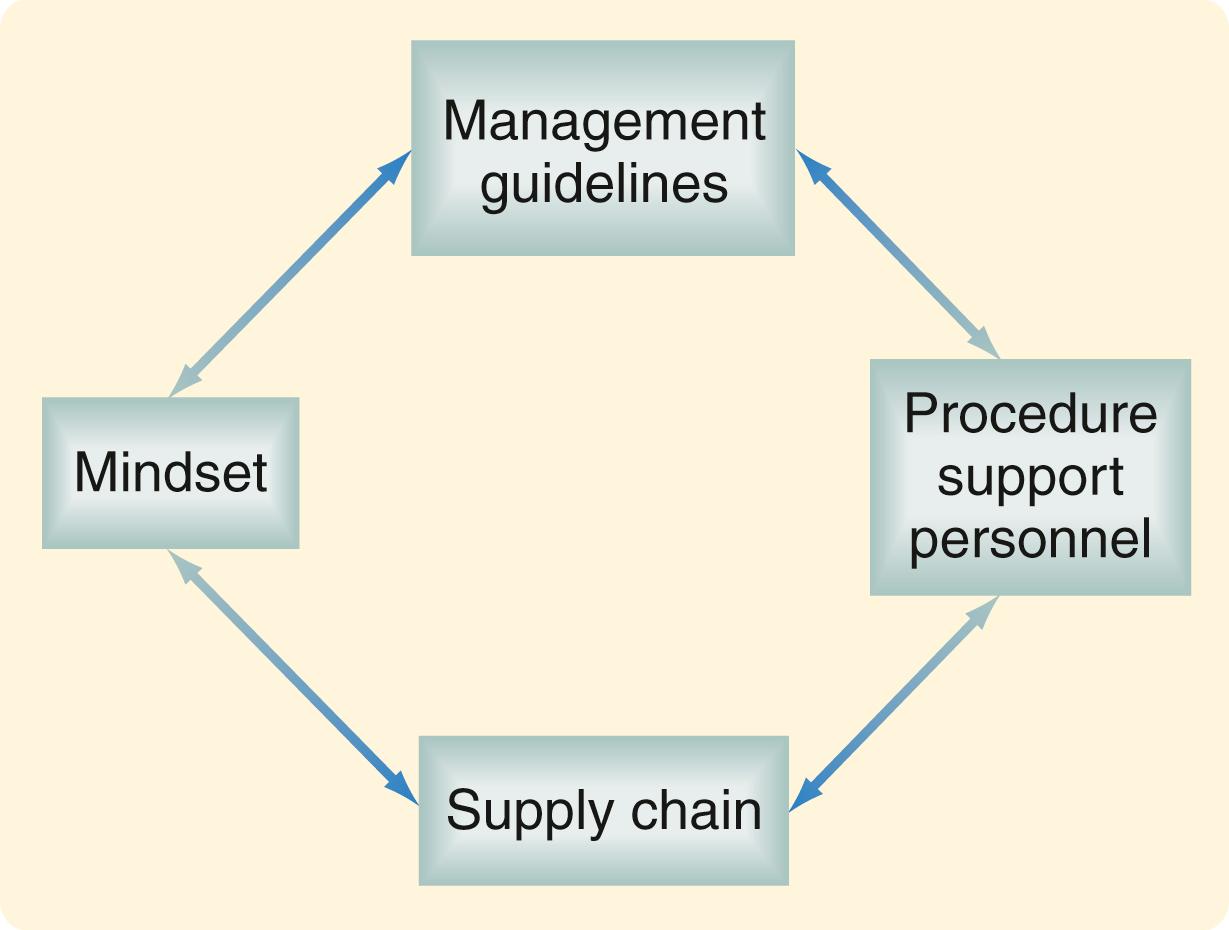Physical Address
304 North Cardinal St.
Dorchester Center, MA 02124
Bedside surgical procedures have become a standard in many intensive care units (ICUs), replacing the operating room (OR) as the preferred location for select procedures in critically ill patients. Performing appropriately selected procedures within the ICU limits the risk of transporting critically ill patients, facilitates flexibility in timing and scheduling, and reduces cost. The ability to perform some operations at the bedside may be lifesaving in critically ill patients too unstable to transport safely to the OR. Advancements in monitoring and sedation, in endoscopic and percutaneous techniques, and in bedside imaging have enabled the transition of several procedures traditionally performed in the OR and endoscopy and interventional radiology suites to the ICU. Some procedures now regularly performed in the ICU include bedside laparotomy, tracheostomy, percutaneous endoscopic feeding access, percutaneous drainage procedures, and the placement of inferior vena cava filters. For example, between 2006 and 2014, more than 2800 percutaneous tracheostomies, 900 percutaneous endoscopic gastrostomy (PEG) or percutaneous endoscopic gastrojejunostomy (PEGJ) tube placements, 450 exploration and irrigation of open abdomens, and 50 exploratory laparotomies were performed at the bedside in the ICUs at Vanderbilt University Medical Center. In the unstable patient, other procedures may be performed at the bedside including irrigation and debridement of wounds, orthopedic stabilization with external fixation, fasciotomies, amputations, and diagnostic laparoscopy.
Although bedside operative procedures can be performed safely, with complication rates equal to those in the OR, doing so mandates that cases are appropriately selected and that appropriate safety practices are consistently implemented. The ICU represents a complex environment in which to perform complex processes and procedures. Recognition of the numerous potentials for error and adverse events in such settings is important. Based on the experience of industry and other high-reliability organizations, prevention of error and adverse events requires standardization of processes and elimination of variability. Protocols and safety practices specifically for bedside operative procedures should be in place to ensure the ability to perform these procedures safely, with low infection rates, and with the assurance of comfort and amnesia. In this chapter, we discuss the following topics:
The rationale for bedside surgical procedures.
Process of bringing the OR to the bedside.
Systematic safety methodologies and practices to ensure safe performance of bedside procedures.
Selection of patients for bedside surgical procedures.
Specific considerations for common bedside procedures:
Bedside laparotomy
Percutaneous tracheostomy
Percutaneous endoscopic feeding tubes
Bronchoscopy.
For good reasons, most surgical procedures are performed in the OR. The centralization of resources, including anesthesia personnel and equipment, surgical equipment, radiology, specialized nursing and procedural support staff, and safety policies and principles, makes the modern surgical suite an ideal venue for most operations ( Fig. 23.1 ). However, OR demand may exceed available resources, complicating timely access to the OR and scheduling of unplanned, urgent, or emergent cases. Competition for OR space may delay or prevent timely operative procedures for critically ill patients. Additionally, performance of procedures in the OR mandate transportation of critically ill patients from the ICU and back and requires substantial resource utilization and costs. As the complexity and severity of illness of critical care patients have increased, so too has the risk related to their transport. The transport of critically ill patients frequently requires multiple personnel, including nursing staff, transport staff, respiratory care, and anesthesia staff. Furthermore, the change of venue and personnel caring for the patient necessitates detailed communication for handoff and represents a potential source of medical error. The transport of a patient from the ICU to the OR is a resource sink, adds cost, and increases risk. Consideration of transport to the OR should be evaluated in the same manner as other treatments by assessing risk versus benefit for the individual patient. Each hospital should have guidelines for the inter- and intrahospital transport of critically ill patients to various parts of the hospital for various imaging, tests, or procedures and to the OR to decrease inherent risk.

While the vast majority of surgical procedures should be performed in the OR, the ICU is a logical alternative location for some surgical procedures. The two locations are similar in many ways. Both locations have monitoring equipment capable of real-time monitoring of cardiovascular, respiratory, and neurologic monitoring. The ICU and OR both have mechanical ventilation capability. In fact, many ICUs have ventilators with more advanced functionalities than their corresponding ORs. Although lacking inhalational anesthetic administration capabilities, intravenous sedation and analgesia can be administered in the ICU to allow for the performance of bedside procedures. Lastly, and most importantly, there are analogous staff in ICU. In the ICU, the roles of circulating OR nurse and anesthesia providers can be filled by the teamwork of a critical care nurse, respiratory therapist, and intensivist. The one crucial OR role not easily translated to the ICU setting is the scrub nurse/technician. Dedicated procedure support personnel have been described in the ICU setting to bridge this gap. In this role, the procedure support nurse is responsible for many of the same functions as the scrub nurse. Dedicated procedure support personnel not only decrease the variability in how an individual procedure is performed, but also they play important roles in compliance to guidelines, both of which are significant factors in reducing error.
Multiple factors are required to create and maintain a successful system for performing bedside procedures ( Fig. 23.2 ). Management guidelines may include standard operating procedures, preprocedure checklists including time-out procedures, and sedation protocols. Appropriate access to supplies may require temporary storage of core equipment in an individual ICU with standardized restocking mechanisms, streamlining the supply chain. Finally, a facilitative mindset among staff is vital to the success of such a system.

To ensure the safety of operative procedures performed at the bedside in the ICU, systematic measures should be in place for appropriate patient selection; adequate expertise of supporting personnel; limited procedural variability; adequate monitoring and anesthesia; and facilitation of concise, accurate, and specific intrateam communication. Measures shown to increase safety in the OR are also appropriate for procedures performed at bedside in the ICU. Implementation of the Safe Surgery Saves Lives program developed by the World Health Organization (WHO) has been associated with a significant global reduction in perioperative morbidity and mortality. The 10 safety objectives outlined in the WHO Guidelines for Safe Surgery 2009 are as follows :
The team will operate on the correct patient at the correct site.
The team will use methods known to prevent harm from administration of anesthetics while protecting the patient from pain.
The team will recognize and effectively prepare for life-threatening loss of airway or respiratory function.
The team will recognize and effectively prepare for risk of high blood loss.
The team will avoid inducing an allergic or adverse drug reaction for which the patient is known to be at significant risk.
The team will consistently use methods known to minimize the risk for surgical site infection.
The team will prevent inadvertent retention of instruments and sponges in surgical wounds.
The team will secure and accurately identify all surgical specimens.
The team will effectively communicate and exchange critical information for the safe conduct of the operation.
Hospitals and public health systems will establish routine surveillance of surgical capacity, volume, and results.
The use of specifically trained procedure support personnel to support bedside operative procedures within the ICU greatly facilitates reduction in variability, compliance with standard operative procedures, reduction of communication errors, and maintenance of appropriate skill sets. Depending on the volume of procedures to be supported, these personnel can be dedicated to a specific unit or service or used to support bedside procedures on numerous services in multiple ICUs. Limiting this procedure support role to a small number of personnel allows a greater degree of expertise to be developed and, in our experience, has been extremely valuable in maintaining procedural safety; this is particularly true with managing the airway and endotracheal tube during percutaneous tracheostomies. Additionally, these individuals are charged with the development and monitoring of safety practices and ensuring their application during all procedures.
Management guidelines, protocols, and standard operating procedures should be in place before the routine performance of bedside operative procedures. They should be in line with procedures developed for the OR and be easily accessible, and compliance should be monitored. Because of variations in specific personnel and practice patterns in various ICUs, documents may be customized to each location to ensure their appropriate application during bedside operative procedures. These documents should address the selection of appropriate cases, mandatory personnel, equipment, medications, and monitoring. An example of a bedside operative guideline is provided in Box 23.1 . All patients should have blood pressure, electrocardiography, pulse oximetry, and ventilation routinely monitored throughout the procedures. Adequate personnel must be present to allow performance of the procedure, monitoring of sedation and anesthesia, medication administration, manipulation of ventilation if required, and documentation. The actual number of personnel required varies depending on the procedure and expertise of particular personnel. Analgesia and sedation must be ensured with appropriate medications under the direction of the adequately credentialed personnel. Additionally, guidelines and protocols should include standards for adequate preparation, equipment, and instrument accounting.
Become a Clinical Tree membership for Full access and enjoy Unlimited articles
If you are a member. Log in here